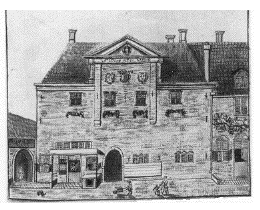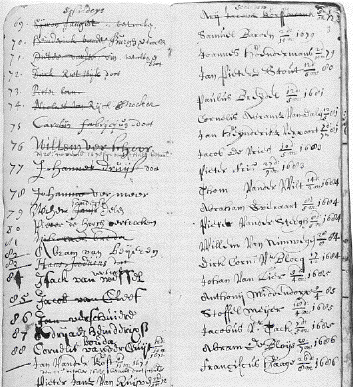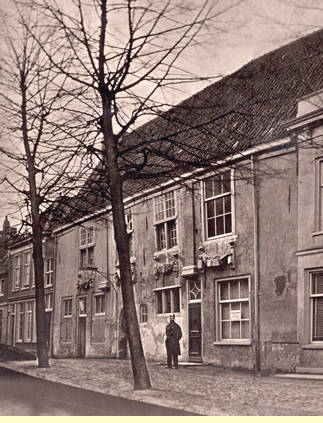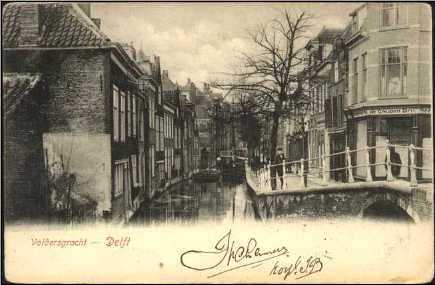 The
Delft St Luke Guild - how it was run
The
Delft St Luke Guild - how it was run
 The
Delft St Luke Guild - how it was run
The
Delft St Luke Guild - how it was runThe Guild of St. Luke building on Voldersgracht number 21, formerly the Old Mens House, was remodeled and inaugurated in 1667. Mechelen's back side looked out upon its facade. All about the physical setting, click interior.
* A digital multimedia center experience about the work of Johannes Vermeer is in the making. If all goes well it will open in the spring of 2006 in the historic town of Delft.
www.vermeerdelft.com in English
www.vermeerdelft.nl in Dutch / Nederlands
When it comes to historical documents, the Delft guild of St Luke from Vermeer’s days has been lost in the mists of time. All of the registry papers once processed by this guild were discarded after the guilds were abolished in the days of Napoleon I. This is, except for one crucial document, a small booklet, now preserved in the Royal Library, The Hague containing the member list of newly enrolled masters. It even contains some of Vermeer’s actual handwriting as he was headman during four one-year periods and within that time in 1662, 1663, 1670 and 1671 he enrolled other members.

We can however piece together the inner workings of this Delft guild as rules and regulations were broadly comparable in all Dutch towns. We are for instance well informed about how the painters’ guild was run in nearby The Hague.
Entrance arrangements
 New
masters about to be tested for admission were let in and out of the building
by the Dean of the Board who took 6 stuivers per day in fee. The candidates
were given a proper test assignment and with their apprentice tools, they had
to produce their masterpiece of professional craft within a given period of
time. Those who failed the test had to wait and try and train again for a period
of 58 weeks. Normally the prouveling, passed, like Vermeer did when successfully
enrolled on 29 December 1653. After passing the board, a new master had to pay
to the guild an entry fee of either 6 or 12 guilders, the latter amount for
a master born outside Delft. Obviously Vermeer paid 6 guilders but he was not
able to come up with the full amount right away.
New
masters about to be tested for admission were let in and out of the building
by the Dean of the Board who took 6 stuivers per day in fee. The candidates
were given a proper test assignment and with their apprentice tools, they had
to produce their masterpiece of professional craft within a given period of
time. Those who failed the test had to wait and try and train again for a period
of 58 weeks. Normally the prouveling, passed, like Vermeer did when successfully
enrolled on 29 December 1653. After passing the board, a new master had to pay
to the guild an entry fee of either 6 or 12 guilders, the latter amount for
a master born outside Delft. Obviously Vermeer paid 6 guilders but he was not
able to come up with the full amount right away.
The guild laws decreed the number of years an apprentice needed to study. For the art of painting this study period was exceptionally long at 6 years. Guilds were setting and protecting quality control standards and maintained craft quality and workshop practices. Membership was reserved for males only, with the exception of widows of deceased member-artisans who were free to continue their husbands’ workshop under their own name. Widows’ names were usually not entered in the guild books. In some cases a widow would opt to marry another man who was master in the same professional field, especially when trying to save a complicated delftware manufacture workshop from going down.
Vermeer had to option but to enroll in the guild, as no economic activity as
an artist was otherwise allowed, neither in selling his own works nor in selling
paintings by other masters. The guild thus fully managed and controlled that
branch of economic activity. Thus the guild system was basically about quality
control and about economic protection, barring influx of outside ready-made
articles.
One of the pressing problems facing the Delft Guild of St Luke and Vermeer as
one of its members was the lack of a daily saleroom facility in Delft for marketing
paintings. Lacking this outlet, some Delft painters opened up their private
fore-houses so that prospective buyers could look at the stock. During just
one week in the year Delft people were free to do art trade during the big annual
fair and market. During that time the sale of paintings was allowed for all,
without restrictions.
Comparing the Situation in The Hague
In nearby The Hague sales were organized about on a more regular and larger
scale. A daily art market existed in the grand Count’s Hall (Ridderzaal)
as well as in the White Gallery near Stadhouders gate. There, the stalls for
selling paintings were often managed by wives of the painters. Trade was especially
brisk around the time of the annual fair.
Once a year a widely advertised grand sale was held in which Hague painters
could enter their works. The 1647 sale for instance, boasted some 1300 paintings,
which netted 8000 guilders at auction, at a mean price of about 6 guilders.
This annual grand sale attracted major professional art traders, but also people
with money to spare and to invest such as mayors, doctors, lawyers, artists,
and political figures like Willem Boreel from Amsterdam, one-time neighbor of
Rembrandt.
Other, smaller-scale ‘vendue’ sales during the year had to be arranged
with the Hague guild and required a listing of all of the works sold, including
the attribution to masters. Because of the large crowds and liberal beer and
wine consumption, these sales were quite popular with innkeepers as well as
with masters of the militia halls.
Within the group of guild painters one should distinguish between on one hand
fine art painters or fijnschilders, the likes of Vermeer and de Hooch,
and on the other hand kladschilders, which could be seen as house painters,
although most were also able to produce fine ornamental designs on doors and
walls. Generally the fine-art painters formed a tightly knit group, taking care
of mutual assistance in buying and selling artists materials, in valuing art
works, in restoring paintings, tipping each other off in art trade, as well
as serving as witnesses in buying and selling paintings and real estate. We
know that some liked to spend leisure time together. In the archival documents
we see that Vermeer was not the proverbial enigmatic recluse, but indeed a full
and active member of a tightly knit community of Delft artists and patrons.
Most artists worked hard at their career, and some succeeded financially and
hit the highest status jackpot when working for the Hague court or foreign courts
and thus landed extravagant commissions and high prices. Most painters just
scraped by. Painters could make additional income by teaching pupils, although
we do not know whether Vermeer had one. In a certain sense Vermeer took a middle
position as he married into a wealthy family and as one single patron decided
to favor him during many decades, buying up half of his output.
Varying from town to town the various types of craftsmen were grouped within
guilds in different ways. The St Luke’s guild in Delft contained artists
and artisans in the following very wide circle, made up of what we may term
‘creative’ workers: there were fine art painters, painting dealers,
Delftware faience manufacturers, printers, engravers, sculptors in wood - also
sculptors in stone or other fine substances such as ivory. Furthermore we find
included within this guild: architects, tapestry weavers, embroiderers, glass
makers, glass painters, glass sellers, engineers, surveyors, mapmakers, map
coloring specialists, calligraphers, typeface makers, printers, book binders,
and as the proverbial odd ones out, chair painters, and a furniture joiner.
In Delft they goldsmiths were grouped in a separate guild.
St. Luke’s Guild at Voldersgracht thus formed a HQ of a formidable economic
business and a hub of professional activity. At the Delft St Luke guild a master
in one type of trade could meet masters other branches such as those of the
rapidly expanding Delftware industry, forming a large and extremely successful
expanding group. The total number of inhabitants in Delft in 1650’s varied
between 45.000 and 50.000. Vermeer met masters from the Delftware trade and
it may be possible that he became inspired by the use of blue colors on tiles
and by the simplified outlines and strong design shapes.
Membership of the guild brought along benefits, obligations and rules. A member
was for instance not allowed to take over another member’s job except
for in cases of force majeure such as illness or drunkenness. A simple sick
benefit system existed, providing income and medical aid in case a member got
seriously ill. Members were expected to attend at funerals of other members.
Fees and fines for trespassing these rules were collected by a footman.
Having had this well-oiled guild system going since the Medieval era, town magistrates
felt comfortable in actually handing over day-to-day management to a board of
knowledgeable and able men called ‘syndics’ or ‘headmen’
of the guild. They were first elected from within the guild ranks and their
appointments were ratified by the town magistrates. Vermeer made it to this
elevated board position a number of times, starting out at a relatively young
age in 1662, 1663 and again serving in 1670 and 1671. Gathering annually in
Delft on October 18, the day of their patron saint St Luke, all members convened
and elected their future officers.
In the guild book we see that annually four headmen and from the 1640’s
on six headmen were installed, often including two or more painters. Subsequently
the Burgomasters and Aldermen OK’ed the suggested shortlist of officers
just before the end of the year. In order to settle important decisions, board
members met for official business every 4 weeks on Monday at 5 o’clock.
Not turning up when one should have done so cost each a fine of 24 stuivers.
On the Internet one may find the full clickable list of names and you can read
about their backgrounds and relationships. Please go to www.google.com and type
“Obreen + Kaldenbach”.
Artists materials
Guilds were a proud institution in city life. In mediaeval guilds held colorful
festive religious processions on Market Square several times a year. After the
protestant takeover in the 1580’s this tradition was first allowed to
continue, but it was repressed some years later on, as it harked back too much
at Saint-oriented popish religious sentiments.Fine art painters or fijnschilders
needed artist materials. Because of the very large amounts of color pigments
used in workshops in the Delftware industry, there was volume of trade and a
high level of expertise regarding these materials, both in raw form and in cleared
and refined, powdered form.
Painters could make a choice. They could invest their own time, buying raw materials
and grind these, mixing in oils and drying agents, storing these hand made paints
in pig bladders. They could also invest time and stretch and mount their own
canvases, priming them with layer upon layer of gesso, thus forming a smooth
and stable white background for canvas paintings. Because of modern techniques
such as x-ray we have come to learn a lot about the supports Vermeer used. Most
were of a standard commercial size.
Alternatively, in order to save time and to benefit from the professional expertise of others, many artists may have preferred to use the more expensive ready-made artists materials. Ground-up pigments, ready-made paints tied-up pig bladders, liquids and various sizes of canvases could be had off the shelf from specialized art dealers. These were the specialized art supply grocer nicknamed the colorman. In Delft one such colorman was Leendert Volmarijn . Alternatively a painter could shop around for raw or refined materials at the local apothecaries, who would in turn have obtained materials from wholesale colorman dealers in Amsterdam, Haarlem or Rotterdam. In 1664 Just one Delft apothecary bill crops up in Vermeer documents known to us, that of Dirck de Cocq, involving artist materials delivered to Vermeer, such as lead tin yellow and some other items.
The actual building was demolished in 1876 when a town school was built on that spot - see aerial photo 1923. Another elementary school was built at that site since.
Architectural festoon ornaments salvaged from the ancient bulding are now in a wall in the south garden of the Rijksmuseum, Amsterdam, just above the large brass letters "RIJKSMUSEUM".


This page forms part of a large encyclopedic site on Delft. Research by Drs. Kees Kaldenbach (email). A full presentation is on view at johannesvermeer.info.
Launched 16 February 2005; Last update March 1, 2017. More info in the RKD site.
Top: Anonymous drawing, Washington, National Gallery of Art.
Mechelen inn was demolished and is now a vacant lot - see aerial photo 1923.
